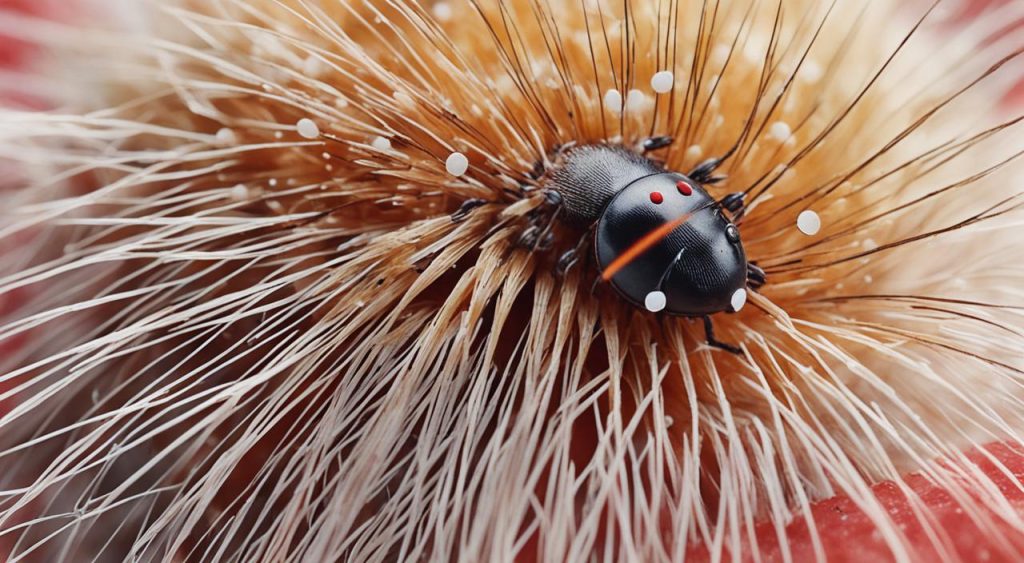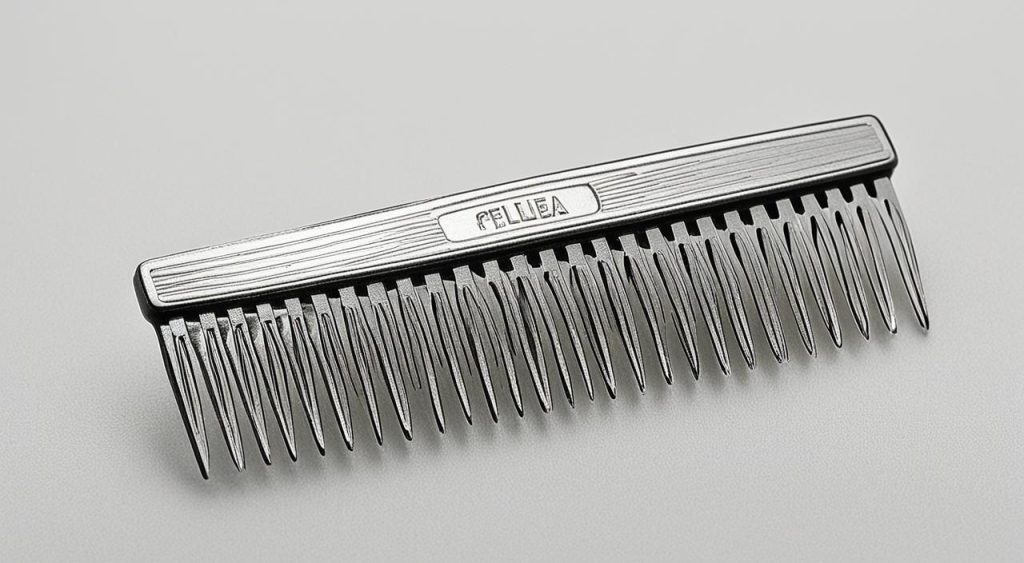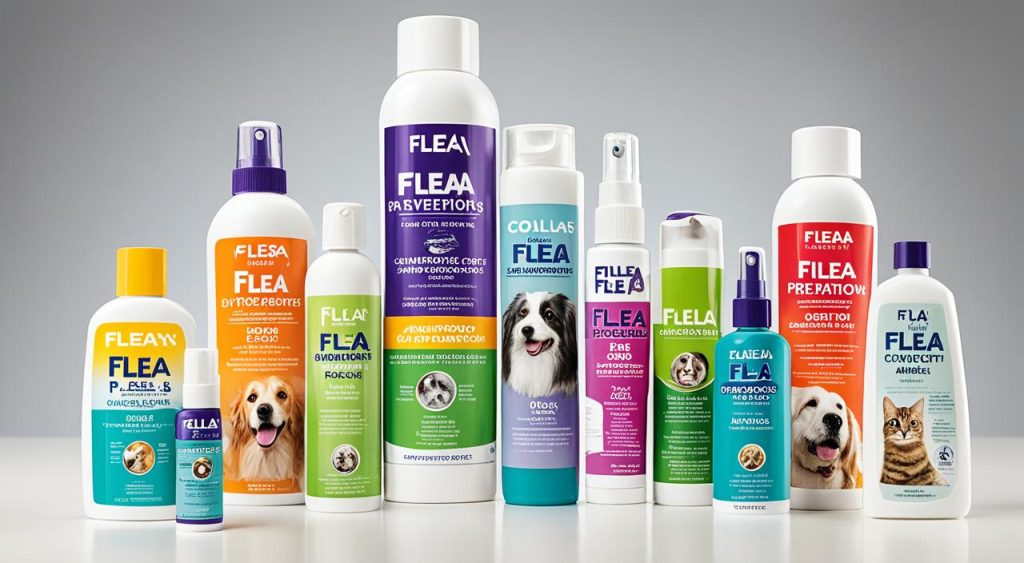Fleas and ticks are common pests that can bother dogs and cause health issues. It’s important to keep your dog safe from these pests. Fleas can grow in number quickly, leading to anemia, skin problems, and even diseases.
Ticks also bring risks, like spreading diseases like Lyme disease and Rocky Mountain spotted fever. It’s key to prevent and watch out for these pests to keep your pet and family safe. By learning about fleas and acting early, you can fight these pests and keep your dog healthy.
Understanding the Flea Threat
Fleas are more than just a bother to dogs; they are a serious health risk. These tiny pests can lead to anemia from blood loss and can spread dangerous tapeworms. They can also cause skin irritation, allergies, and infections, making your dog uncomfortable and at risk of more problems.
Flea infestations can grow fast, as female fleas lay over 20 eggs daily. This leads to a quick increase in their numbers. Reports from the Los Angeles County Department of Public Health show small outbreaks of flea-borne typhus. The cat flea is especially harmful, causing allergic dermatitis in humans and hosting tapeworms in pets.
Fleas and Serious Health Risks
- Anemia from blood loss due to heavy flea infestations
- Transmission of tapeworms, which dogs can ingest by swallowing infected fleas
- Skin irritation, allergies, and infections caused by flea bites
Tilly Walker from WeWantDogs says, “Fleas can make dogs very uncomfortable. Their bites cause skin problems, itchiness, irritation, diseases, allergies, and infested homes. These pests can seriously affect dogs’ health.”
| Health Issue | Impact on Dogs | Potential Consequences |
|---|---|---|
| Anemia | Blood loss from heavy flea infestations | Weakness, lethargy, and potential organ damage |
| Tapeworms | Transmitted through infected fleas | Digestive issues, weight loss, and general discomfort |
| Skin Irritation | Caused by flea bites and allergic reactions | Scratching, hot spots, and increased risk of infections |
Fleas can be a big threat to your dog’s health and happiness. It’s important to take steps to prevent and get rid of these pests. By knowing the risks, pet owners can better protect their dogs and keep them healthy.

Identifying Signs of Flea Infestation
It’s important to check your pet’s coat and skin often for early signs of fleas. Look for these signs to see if your pet might have fleas:
Flea Dirt
Check for small, dark specks in your pet’s fur that look like ground pepper. These are dried flea excretions, or “flea dirt.” They turn reddish-brown when wet because fleas eat blood.
Skin Irritation and Excessive Scratching
Flea bites can make your pet’s skin red and irritated. You’ll often find these spots on the belly, back, neck, and ears. Your pet may scratch, lick, or bite these areas to try to ease the discomfort.
Visible Fleas
Fleas are tiny, under ⅛-inch long, and you might see them moving in your pet’s fur. They’re usually brown, black, or reddish and have six long legs for jumping.
By checking your pet often, you can spot fleas early and deal with them before they spread. Remember, stopping fleas before they start is the best way to keep your pet safe from their discomfort and health risks.

| Flea Life Stage | Characteristics |
|---|---|
| Eggs | White, oval, and only about half a millimeter long |
| Larvae | About 2-5 mm long, they burrow into carpets, furnishings, and cracks to develop into pupae |
| Pupae | Cocoon stage where fleas develop and emerge as adults |
| Adult Fleas | Less than ⅛-inch in length, brown, black, or reddish in color, with six long legs that allow them to jump quickly |
Flea Prevention Techniques
Keeping your dog free from fleas is key to their health and happiness. Using a mix of methods can stop fleas from taking over. Let’s look at the main ways to prevent fleas.
Use a Flea Comb
Using a flea comb often is a great way to find and remove fleas from your dog. Go through your pet’s fur carefully, looking for flea dirt or eggs. Throw away any fleas you find to stop them from spreading in your home.
Bathe with Insecticidal Shampoos
Washing your dog with insecticidal shampoos can kill fleas and stop them from breeding. Make sure to pick a shampoo that’s safe for your pet. Talk to your vet to find the right one.
Schedule Professional Grooming
Getting help from a professional groomer can really help with flea control. They know how to check for fleas and remove them. This can make a big difference in keeping your pet flea-free.
Maintain a Clean Environment
It’s important to keep your home and your dog’s area clean to prevent fleas. Vacuum often, wash your dog’s bed, and don’t let clutter build up. This stops fleas from hiding and breeding.

“Prevention is always better than cure when it comes to fleas. By taking a comprehensive approach, you can help keep your pet safe and comfortable, while also avoiding the hassle and potential health risks associated with flea infestations.” – Dr. Jerry Klein, Chief Veterinary Officer, American Kennel Club
Medications and Preventive Products
Keeping your furry friend safe from fleas and ticks is key for their health. There are many flea medications and flea prevention products out there. Options like Frontline, Nexgard, and Bravecto kill fleas and stop more from coming back with monthly use.
Flea collars like the Seresto collar give long-lasting protection. They slowly release insecticide for several months. For quick relief, Capstar and Credelio are oral treatments that kill fleas fast. But, they don’t prevent future infestations. Shampoos, sprays, and powders also help, but you’ll need to use them more often.
| Product | Type | Protection Duration | Key Features |
|---|---|---|---|
| Frontline | Spot-on treatment | 1 month | Kills fleas, ticks, and lice |
| Nexgard | Oral medication | 1 month | Kills fleas and ticks |
| Bravecto | Oral medication | 3 months | Kills fleas, ticks, and mites |
| Seresto | Flea collar | 8 months | Kills and repels fleas and ticks |
Talking to your vet is crucial to find the best flea prevention products for your pet. They’ll consider your pet’s age, breed, lifestyle, and health to recommend the right option.

Natural Remedies for Flea Control
Many pet owners look for natural ways to fight fleas instead of traditional treatments. Essential oils, herbs, and a clean home can help keep fleas away naturally.
Essential Oils and Herbs for Flea Repellent
Lavender, eucalyptus, and citronella essential oils can keep fleas away. You can mix these oils in a spray to mist your pet or use them in a diffuser at home. Herbs like rosemary and mint also help keep fleas away and can be used in homemade remedies.
Maintaining a Clean Environment
Fleas like dirty, cluttered places, so a clean home is key. Vacuum often, wash your pet’s bedding in hot water, and get rid of places where fleas can hide. Sprinkle boric acid in cracks to kill fleas.
It’s important to talk to your vet before trying natural remedies to make sure they’re safe for your pet. Using these natural methods and staying clean can keep your pet free from fleas without harsh chemicals.
| Natural Flea Remedy | Effectiveness | Safety Considerations |
|---|---|---|
| Lavender oil | Proven to repel fleas | Avoid direct application on pets |
| Rosemary and mint | Natural flea deterrents | Generally safe for pets when used properly |
| Boric acid | Effective desiccant for fleas | Avoid prolonged exposure or ingestion |
| Diatomaceous earth | Kills fleas within 4 hours | Avoid inhaling the powder |
| Vinegar and water spray | Repels fleas on surfaces | Safe for pets and humans |
“A combination of natural remedies, care, and vet’s help can help control fleas effectively.”
Early Detection and Regular Check-ups
Keeping your pet safe from fleas and ticks means being proactive. Regular grooming and yard care are key steps in catching fleas early. Brushing your pet often helps you see signs like flea dirt or dried blood. Also, check your yard for places where fleas and ticks might hide, like tall grass and thick bushes.
It’s important to take your pet to the vet regularly. They can check for signs of flea problems, like high white blood cell counts or anemia. Then, they can suggest the best ways to prevent and treat these issues based on your pet’s needs and life.
- Brush your pet’s coat regularly to spot early signs of fleas or ticks
- Maintain a clean, clutter-free environment in your yard to discourage pests
- Schedule routine vet visits to ensure your pet’s overall health and wellness
By being proactive with flea detection, regular grooming, vet visits, and yard maintenance, you can beat these pests. This keeps your furry friend happy and healthy.
“Consistency is key when it comes to protecting your pet from fleas and ticks. Regular check-ups and preventive measures can make all the difference.”
Choosing the Right Flea Products
Protecting your furry friend from fleas is key. Talk to your vet to find the best flea prevention for your dog. You’ll find many options, from natural shampoos to long-lasting collars.
Navigating the Flea Product Landscape
Start with natural shampoos that use neem oil or chamomile. These can keep pests away without harsh chemicals. Spot-on treatments and flea collars also work well, offering long-lasting protection.
Think about products that fight different parasites like ticks and heartworms. Isoxazolines are a new type of drug that works against many pests. They can even tackle ear mites and home infestations.
Remember, you need to use flea and tick treatments all year. These pests can live in many temperatures. Choose treatments that last at least a month to keep your pet safe.
Evaluating Flea Product Effectiveness and Safety
Look at the type of application, what it covers, and when you can start using it. Your vet can help pick the best option for your pet. Be aware of possible side effects, like vomiting from some oral meds.
Working with your vet and picking safe, effective flea products keeps your pet happy and healthy. It also prevents the problems and risks that fleas bring.
| Flea Product | Key Features | Recommended Age | Duration of Protection |
|---|---|---|---|
| Seresto® Collar | Effective against fleas and ticks | Puppies 7 weeks and older | Up to 8 months |
| Frontline® Plus | Kills chewing lice and helps control sarcoptic mange | Puppies 8 weeks and older | Up to 1 month |
| Advantage Multi® | Kills heartworms, hookworms, whipworms, roundworms, and fleas | Puppies 7 weeks and older | Up to 1 month |
| Simparica Trio Chewable Tablets | Protects against fleas, ticks, heartworm, hookworm, and roundworm | Dogs 8 weeks and older, weighing at least 2.8 pounds | Up to 1 month |
“Flea and tick treatments must be consistently administered year-round for effective parasite control.”
Common Mistakes to Avoid in Flea Control
Keeping your pet safe from fleas and ticks needs careful attention. Many pet owners make mistakes that can harm their pet’s health. It’s important to avoid these mistakes to keep your pet well.
One big mistake is using flea control products the wrong way. Some pet owners don’t talk to a vet before using these products. This can make them toxic or not work. Always pick products that are safe for your pet’s age, weight, and needs.
Not treating outdoor areas where fleas and ticks live is another mistake. These pests can get into your home on your pet. So, treat your pet and their outdoor spaces too.
- Irregular grooming can lead to more fleas. Regular brushing and baths with special shampoos can help stop them.
- Thinking fleas and ticks are only a problem during certain seasons is wrong. They can be active all year. Not controlling them all the time can leave your pet at risk.
- Using DIY treatments you find online can be bad for your pet. Always talk to your vet for safe ways to control fleas and ticks.
Avoiding these mistakes is key to keeping your pet safe and flea-free. Stay alert, talk to your vet, and use a consistent prevention plan. This way, your pet will be happy and healthy.
| Mistake | Consequences |
|---|---|
| Improper product use | Potential toxicity or ineffectiveness |
| Overlooking outdoor spaces | Fleas and ticks can easily enter the home |
| Irregular grooming | Buildup of fleas and ticks |
| Seasonal assumptions | Leaving pets vulnerable year-round |
| Relying on DIY treatments | Ineffective and potentially harmful |
“Consistent, effective flea and tick prevention is essential for maintaining your pet’s health and preventing infestations.”
Flea Infestation Risks and Consequences
Fleas are more than just annoying. They can be harmful to pets and people. A bad flea problem can cause serious health issues, like anemia and disease spread.
Anemia and Tapeworm Transmission
Fleas suck blood, which can make dogs anemic. They also carry tapeworms, which can infect dogs. These worms can cause stomach problems, weight loss, and poor health.
Skin Problems and Infections
Flea bites can irritate a dog’s skin, cause allergies, and lead to infections. Dogs may scratch and bite themselves, letting bacteria in. This can cause more skin issues, hair loss, and other problems.
Disease Transmission
Fleas can spread diseases like Bartonellosis, which causes fever, diarrhea, vomiting, and seizures. In some places, they can also spread plague and murine typhus.
It’s important to treat and prevent flea problems quickly. Checking for fleas often and controlling them can protect your pet and family’s health.
“Fleas are not just a nuisance – they can pose serious health risks to both pets and their owners.”
Professional Flea Control Services
Dealing with fleas and ticks can be tough. That’s why many turn to professional pest control services. ABC Pest Control has over 60 years of experience. They offer treatments for both inside and outside your home.
ABC’s experts carefully check your home for fleas and ticks. They find where these pests hide and use proven methods to get rid of them. Their treatments use the least amount of chemicals but are still very effective. They also offer ongoing services to keep pests away for good.
Trying to fight fleas and ticks on your own can be hard. These pests can live up to two weeks off a host. ABC Pest Control offers a full solution that targets all life stages of fleas and ticks. They use safe and effective products, ensuring your home is pest-free.
FAQ
What are the health risks posed by fleas to dogs?
Fleas can cause serious health problems in dogs. These include anemia from blood loss and skin issues like irritation and infections. They can also carry bacteria that lead to diseases like Bartonellosis.
How can I identify signs of a flea infestation on my dog?
Look for signs like flea dirt, red bumps, and skin irritation. Watch for your dog scratching or licking too much. You might also see fleas moving in their fur.
What are some effective flea prevention techniques?
Use a flea comb and bathe your dog with insecticidal shampoos. Regular grooming helps too. Keeping your home clean also prevents fleas.
What types of flea medications and preventive products are available?
There are many options like oral and topical medications, flea collars, and spot-on treatments. Natural remedies like essential oils and herbs can also help prevent fleas.
How can natural remedies help with flea control?
Natural remedies like lavender and eucalyptus essential oils can repel fleas. Keeping your home clean and free of clutter also helps keep fleas away.
How often should I check my dog for fleas and ticks?
Check your pet often, especially if they go outside. Look for ticks or fleas on them. Also, check your yard for signs of fleas. Regular vet visits help keep your pet healthy and get advice on prevention.
How can I choose the right flea products for my dog?
Talk to your vet to find the right flea prevention products. They can recommend pet-friendly options like natural shampoos, spot-on treatments, and collars.
What are some common mistakes to avoid in flea control?
Avoid using the wrong products without a vet’s advice. Don’t ignore outdoor areas where fleas and ticks live. Regular grooming is key, not just when problems start. Fleas and ticks are not just seasonal pests. Don’t rely on DIY treatments from the internet.
What are the consequences of a severe flea infestation?
A bad flea infestation can cause anemia, tapeworms, skin problems, and infections. It can even lead to diseases like Bartonellosis.
When should I consider hiring professional flea control services?
Getting rid of fleas and ticks on your own can be hard. It’s best to hire experts. They can find all the fleas and ticks and treat your home effectively.




